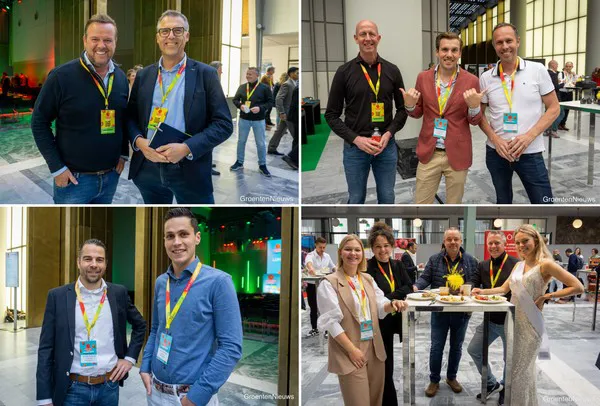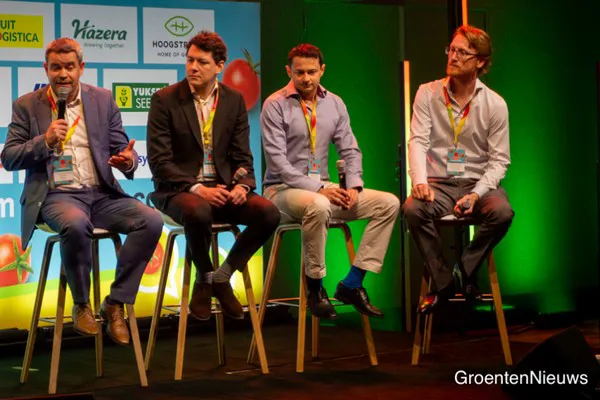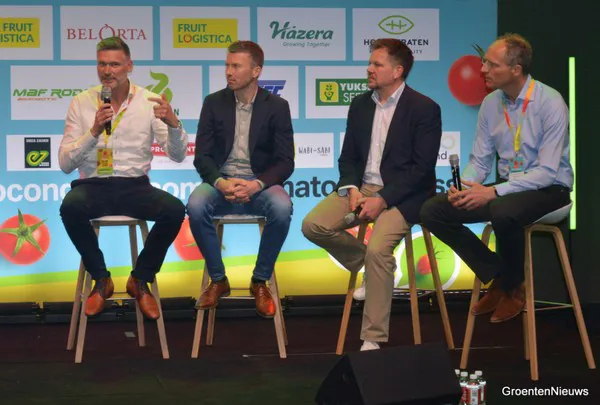Are you packing your tomatoes in black or white? According to research presented at the Global Tomato Conference, the contrast of the black packaging could increase sales. The event, which took place at the World Trade Center in Rotterdam, covered various familiar themes such as labor, viruses, automation, and marketing. Throughout the day, a series of speakers from different sectors, including growers, breeders, technology providers, and marketers, shared their thoughts on challenges and opportunities in the industry.

Click here for the photo report.
 Over 250 visitors were present for the opening of the Tomato Congress, which is organized annually by Fruitnet.
Over 250 visitors were present for the opening of the Tomato Congress, which is organized annually by Fruitnet.
To kick off the day, discussions revolved around the numerous challenges faced by the tomato industry. Cindy Van Rijswick from Rabobank Research Food & Agribusiness and Luc Vanoirbeek, representing VBT and Copa Cogeca, highlighted the experts' role in managing crises. Particularly interesting was Cindy's observation that tomato growers have fared quite well, even despite the recent challenges. She acknowledged the initial panic at Rabobank during the energy crisis but pointed out that strategic decisions, including selling electricity or securing gas contracts, allowed growers to overcome the difficulties successfully.
While challenges were a central focus, the primary topic of discussion at the congress remained the increase in tomato consumption. However, Luc expressed his belief that simply maintaining the status quo would not address the market challenges effectively. He also touched upon political matters, highlighting the relevance of certain EU goals from as early as 1958. Luc emphasized the importance of the Farm to Fork strategy followed by the European Union, emphasizing the need for fairness, affordability, and a realistic approach. He also provided insights into inflation figures, explaining their impact on competition between countries.
Unlike previous years, most presentations were consolidated on the main stage, with fewer sessions on side stages. This year, only Source.ag, MetoMotion, and Delphy were given the opportunity to present their product developments in automation, artificial intelligence, and robotics.

During a panel discussion, four industry experts took the stage after the first break. Dirk Aleven from FoodVentures, Imre Vellenga from Agro Care Growers, Philippe Appeltans from BelOrta, and Adam Davy from ICA engaged in a lively debate on the challenges faced by the tomato market and how the industry should respond. Philippe addressed the issue of tomato shortages in the United Kingdom during the previous winter and advocated for the establishment of more producer organizations in the UK to encourage supermarkets to pay fair prices for tomatoes. Philippe noted that despite the availability of tomatoes from BelOrta, there were shortages due to a slightly higher price. He summarized the situation as "penny wise, pound foolish."
Imre discussed Agro Care's ambition to expand to 1,000 hectares by 2030 and explained how growers are choosing to cultivate tomatoes in multiple countries to mitigate risks. Dirk emphasized the importance of resilience, which has become the key since the onset of the COVID-19 pandemic. Adam echoed this sentiment, emphasizing the need for strong relationships between growers, breeders, and retailers. He emphasized that relying solely on the Netherlands in the summer and Spain in the winter is no longer a viable strategy, as more countries are entering the market, including Morocco. However, it was unfortunate that the scheduled speaker from Delassus was not present on stage to provide further insights into the topic.
Morocco was a recurring topic throughout the event, followed by discussions on Tunisia and Turkey to a lesser extent. Towards the end of the program, Karin Gorree from Normec Foodcare discussed the state of tomatoes on Dutch supermarket shelves during the past winter, including imported tomatoes.
In the winter of 2022-2023, the analyzed Dutch beefsteak tomatoes were found to be of higher quality compared to the previous winter of 2021-2022. Notably, these tomatoes also outperformed their Spanish competitors in terms of quality. The Spanish produce experienced more spoilage, although it had a higher Brix level. However, the tough skin of Spanish tomatoes resulted in lower scores.
On the other hand, Dutch snack tomatoes received lower ratings in quality. There has been a noticeable surge in the popularity of Moroccan tomatoes, which also demonstrated good quality. Some consumers found Dutch tomatoes to be too mealy, and this winter, they were softer compared to the previous season. Surprisingly, in consumer tests, soft and mealy fruits received harsher criticism than tomatoes with a bland taste.
ToBRFV: Addressing the challenges of tomato quality and resistant varieties
The issue of tomato quality did not receive much attention during the ToBRFV program segment. However, discussions on the sidelines revealed concerns regarding the quality of resistant tomato varieties.
Onstage, the focus shifted to discussing the resistance itself. Jeroen Rouppe van der Voort from Enza Zaden delved deep into the high resistance claimed by Enza Zaden. Rijk Zwaan also asserted a high level of resistance, as testified by grower Christian Zeiler. Zeiler shared his experience in using highly resistant varieties to combat the virus problem. The grower commended all breeding companies for their efforts in tackling the ToBRFV issue.

Interestingly, Zeiler opted to plant resistant varieties after an infection but did not prioritize additional hygiene measures. In contrast, Ruud Kaagman from Syngenta and Rick van Meurs from Rijk Zwaan emphasized the importance of hygiene alongside resistant varieties. If the virus pressure remains high, there is a risk of virus mutations, which everyone wants to avoid.
Technological Innovations: meeting market expectations
The market eagerly anticipates practical and mature technological innovations, including those derived from robotics and artificial intelligence. Options were presented on both the main stage and side podium, showcasing advancements in the field.
While the feasibility of implementing these technologies in all operations remains uncertain, the presentations certainly sparked thoughtful discussions. For instance, Certhon presented a concept of growing tomatoes in gutters, akin to lettuce production. Polybee introduced a drone that collects data, aids in pollination, and predicts harvest yields.
Particularly, Polybee is still relatively unknown in the industry. Thus, this conference served as an excellent opportunity for introduction and networking. Attendees took full advantage of the breaks to catch up with familiar faces. For a comprehensive visual experience, please refer to the photo report.
